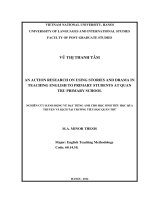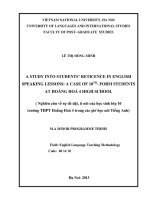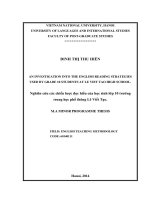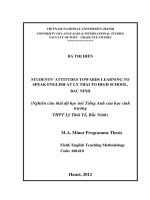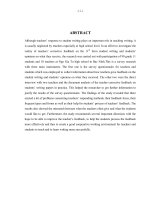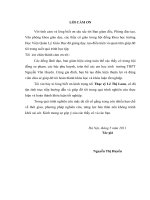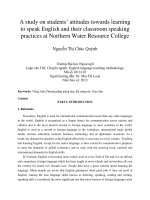Students' attitudes towards learning to speak English at Ly Thai To high school = Nghiên cứu thái độ học nói Tiếng Anh của học sinh trường THPT Lý Thái Tổ, Bắc
Bạn đang xem bản rút gọn của tài liệu. Xem và tải ngay bản đầy đủ của tài liệu tại đây (1.01 MB, 73 trang )
VIETNAM NATIONAL UNIVERSITY-HANOI
UNIVERSITY OF LANGUAGES & INTERNATIONAL STUDIES
FACULTY OF POST – GRADUATE STUDIES
*****************
BÁ THỊ HIỀN
STUDENTS’ ATTITUDES TOWARDS LEARNING TO
SPEAK ENGLISH AT LY THAI TO HIGH SCHOOL,
BAC NINH
(Nghiên cứu thái độ học nói Tiếng Anh của học sinh
trường
THPT Lý Thái Tổ, Bắc Ninh)
M.A. Minor Programme Thesis
Field: English Teaching Methodology
Code: 601410
Hanoi, 2012
iv
TABLE OF CONTENTS
DECLARATION
i
ACKNOWLEDGEMENTS
ii
ABSTRACT
iii
TABLE OF CONTENTS
iv
TABLE OF FIGURES
vi
CHAPTER ONE: INTRODUCTION
1
1.1 Rationale of the study
1
1.2 Aims of the study
1
1.3 Research questions
2
1.4 Scope of the study
2
1.5 Methods of the study
2
1.6 Significance of the study
2
1.7 Design of the study
3
CHAPTER TWO: LITERATURE REVIEW
4
2.1 Attitudes in language learning
4
2.1.1 Definition of “attitude”
4
2.1.2 Roles of learners‟ attitudes in language learning
4
2.2 Speaking
5
2.2.1 Concepts of speaking in foreign languages
5
2.2.2 The role of speaking in foreign language teaching and learning
6
2.2.3 Characteristics of a successful speaking lesson
7
2.2.4 Approaches to teaching and learning speaking skills
8
2.2.5 Factors affecting students‟ participation in speaking activities
11
CHAPTER THREE: METHODOLOGY
15
3.1 The setting
15
3.2 The textbook
15
v
3.3 The participants
15
3.4 The data collecting instruments
16
3.5 Data collection and analysis procedure
17
CHAPTER FOUR: DATA ANALYSIS AND DISCUSSION
19
4.1 Data analysis of students‟ questionnaire
19
4.1.1 Students‟ general attitudes towards learning English
19
4.1.2 Students‟ attitudes towards learning to speak English
20
4.1.3 Students‟ opinions about factors affecting them in learning to
speak English
27
4.1.4 Students‟ attitudes towards teacher‟s teaching method in
speaking lessons
29
4.1.5 Students‟ expectations to learning to speak English
31
4.2 Data analysis of classroom observations
33
4.3 Data analysis of teachers‟ interviews
37
4.4 Chapter summary
38
CHAPTER FIVE: CONCLUSIONS
39
5.1 Summary of findings
39
5.2 Suggestions for teachers
40
5.3 Limitations and suggestions for further studies
42
5.4 Conclusion
43
REREFENCES
44
APPENDICES
I
Appendix 1: Survey questionnaire for students
I
Appendix 2: Classroom observation sheet
XI
Appendix 3: The observed lesson plan 1
XII
Appendix 4: The observed lesson plan 2
XIV
Appendix 5: Interview questions for teachers and transcription
XVII
Appendix 6: A sample lesson plan
XX
vi
TABLE OF FIGURES
Figure 1: Students‟ general attitudes towards learning English
19
Figure 2: Students‟ favorite English lessons in the classroom
20
Figure 3: Students‟ awareness about the importance of English speaking
21
Figure 4: Students‟ evaluation of English speaking lessons in class
22
Figure 5: Students‟ assessment of speaking topics in the textbook
“Tieng Anh 10”
23
Figure 6: Students‟ frequency of feeling unwilling to speak English
in the classroom
24
Figure 7: Students‟ preference in practicing speaking English in class
25
Figure 8: Students‟ self-judgment about their English speaking ability
26
Figure 9: The things students do in the speaking class
27
Figure 10: Factors affecting students‟ English speaking learning
28
Figure 11: Students‟ attitudes towards teacher‟s teaching method in speaking
lessons
30
Figure 12: Students‟ expectations to learning to speak English
32
1
CHAPTER ONE: INTRODUCTION
1.1 Rationale of the study
Among the four language skills known as listening, speaking, reading and
writing, speaking skill is considered the most significant one that most learners of
foreign languages need to achieve because it shows learners‟ proficiency in that
language . Pattison (1992) also shows that when people mention knowing or
learning a language, they mean being able to speak the language. Being an English
teacher, the researcher thinks that speaking should be paid much attention to in the
process of teaching and learning. However, the fact at the researcher‟s school is that
students have poor ability to speak English although they have been learning
English since they were in grade 3 or 4. They speak English badly even in English
speaking lessons. They often feel unconfident and confused when their teachers ask
them to speak English. They regularly find it difficult expressing their ideas in
English and even some students cannot speak anything except “sorry, I don‟t
know”. This problem is also mentioned by the researcher‟s colleagues when they
usually tell her that in their speaking lessons students are very lazy and do not
participate much in speaking activities. Therefore, this problem needs improving to
help students in her school have better English speaking ability.
For such reasons, the researcher conducted this study to investigate the
students‟ attitudes towards learning to speak English and the reasons why they had
these attitudes. By doing the study, she can know more about her students‟
expectations for learning English speaking skills at her school so that she could give
some suggestions which might be useful for teachers and students at Ly Thai To
high school to develop speaking skills for their students.
1.2 Aims of the study
This study is aimed at:
- finding out Ly Thai To high school‟s students‟ attitudes towards learning
English speaking skills and the reasons why they had such attitudes.
2
- giving some suggestions useful for Ly Thai To high school‟s teachers to
develop their students‟ speaking skills.
1.3 Research questions
The above aims of the study can be realized by answering the following
research questions:
(1) What are Ly Thai To high school‟s students‟ attitudes towards learning
English speaking skills?
(2) Why do they have these attitudes towards learning to speak English?
1.4 Scope of the study
As stated above, the study was designed to find out the students‟ attitudes
towards learning to speak English. Because of limited time and experience, the
study was not carried out on a large scale. The study, therefore, was restricted to the
10
th
graders at Ly Thai To high school only.
1.5 Methods of the study
To conduct the study, both quantitative and qualitative methods were used,
involving the survey questionnaire, the classroom observations and the interviews.
First, the survey questionnaire was delivered to students to investigate their attitudes
towards learning to speak English. Then, the classroom observations and the
interviews with some English teachers were conducted to get supplementary
information. Finally, the results obtained from the questionnaire, the classroom
observations and the interviews were discussed and analyzed to with a hope for
providing some useful suggestions for teachers to develop speaking skills for
their students.
1.6 Significance of the study
The study is conducted with the expectation that its results will be useful for
students and teachers of English at Ly Thai To high school. The study will help
3
teachers understand more about their students‟ attitudes towards and expectations for
their learning to speak English. Based on the findings, some suggestions are given to
the teachers to help them improve their students‟ speaking skills. Hence, it could be
a considerable contribution to teaching and learning English speaking effectively
and enjoyably at Ly Thai To high school.
1.7 Design of the study
This thesis consists of five main chapters:
Chapter one is the INTRODUCTION including the rationales, the aims, the
research questions, the scope, the methods, the significant, and the design of the
study. It shows the reason why the author decided to choose this study and the
methods for the fulfillment of the study.
Chapter two is the LITERATURE REVIEW. It is aimed at exploring the
theoretical background for the thesis. It will focus on two main points: attitudes and
speaking.
Chapter three is the METHODOLOGY. Chapter three starts with the
description of the setting and the participants. It also presents how data was
collected through the research methods and research procedures.
Chapter four is the DATA ANALYSIS AND DISCUSSION, in which the
detailed description of data analysis and discussion on the findings of the study are
explained.
Chapter five is the CONCLUSIONS AND RECOMMENDATIONS. This
chapter presents a summary of the findings and draws out some suggestions that are
good for teachers and students in teaching and learning English speaking. The
limitations of the study and some recommendations for further researches are also
discussed in this chapter.
4
CHAPTER TWO: LITERATURE REVIEW
2.1 Attitudes in language learning
2.1.1 Definition of “attitude”
There are many definitions of attitude. Among them Gardner (1985:91-93)
claims that attitude is an evaluative reaction to some referent or attitude object,
inferred on the basis of the individual‟s beliefs or opinions about the referent. In
Gibb‟s view (1988), attitude is generally defined as a state of mind, which is
influenced by feelings, experiences of the world and belief. In addition to that,
Zimbardo, and Leippe (1991) defined attitude as “an evaluative disposition toward
some object based upon cognitions, affective reactions, behavioral intentions, and
past behaviors that can influence cognitions, affective responses, and future
intentions and behaviors”.
The above definitions show attitudes in general understanding, but in the
scale of my study, attitude is understood as „learning attitude‟. According to Oxford
and Shearin (1994), attitude is one of the factors impacting motivation in language
learning. Gardner (1985) stated that positive attitudes and motivation are related to
success in second language learning. Holmes (1992) believes that people develop
attitudes towards languages, which reflect their views about those who speak the
languages, and the contexts and functions with which they are associated. He claims
that attitudes in the context of language learning are defined as the way people look
at the language, the class and the people, and the culture of language.
In short, in language learning, we can see students‟ attitudes in their feelings
and belief about the way of acting towards the lessons, learning style, teachers and
the course books. In this study, it relates to students‟ feelings and belief about
learning to speak English.
2.1.2 Role of learners‟ attitudes in language learning
5
In language instruction, students‟ attitudes towards learning the language are
regarded as “an important predictor of success” since “students who consider the
learning of English as a positive and rewarding experience are less likely to suffer
from foreign language anxiety” (Tsiplakides & Keramida, 2010).
Chambert (1999) asserts that learning occurs more easily, when the learner has
a positive attitude towards the language and learning. Positive attitudes on the part
of the language learners can enhance an integrative motivation, and attitudes upon
success in language learning is widely acknowledged. Also, Holmes (1992) states
that if people feel positive towards those who use the language, they would be more
highly motivated towards learning it.
Unquestionably, good learners are those that have a positive attitude towards
their subject. The overall findings show that positive attitudes have a strong impact
on the success of language learning. Most of the researches have claimed that
students‟ attitude is an integral part of learning and that it should, therefore, become
an essential component of second language pedagogy.
Some factors that influence students‟ attitudes towards their foreign language
learning are identified by Tsiplakides & Keramida, (2010): a) teacher-student
relationships, b) the general classroom atmosphere, and c) the use of authentic
teaching materials and activities. These authors also suggest a number of principles
to foster positive attitudes in ESL/ EFL classes: (1) Developing Teacher-student
Relationship; (2) Fostering a Positive Psychological Classroom Atmosphere; (3)
Creating an Attractive Physical Classroom Environment; (4) Supplementing the
Teaching Material with Authentic Texts and Tasks.
In short, students‟ attitudes play a very crucial role in language learning as
they would appear to influence students‟ success or failure in their learning.
2.2 Speaking
2.2.1 Concepts of speaking in foreign languages
6
Speaking skill has been placed more weight in comparison with other skills as
it is the first step to identify language ability. For many language learners,
“mastering the art of speaking is the single most important aspect of learning a
second language or foreign language, and success is measured in term of ability to
carry out a conversation in the language” (Nunan, 1991: 39). According to Nunan‟s
point of view, it is necessary for teachers of language to pay much attention to
teaching speaking skills in a way that helps learners participate confidently in
transactions.
The importance of speaking raises the needs to understand the nature of
speaking in human interactions. There have been many scholars discussing the
nature of speaking as follows:
Chaney (1998:13) states that speaking is "the process of building and sharing
meaning through the use of verbal and non-verbal symbols, in a variety of
contexts".
Brown (1994) defines speaking as a process of constructing meaning that
involves producing, receiving and processing information.
Bygate (cited in Mackey, 1965:266) shows “oral expression involves not only
the use of the right sounds in the patterns of rhythm and intonation, but also the
choice of words and inflections in the right order to convey the right meaning”.
2.2.2 The role of speaking in foreign language teaching and learning
As mentioned above, speaking skill plays an important role in foreign
language learning because effective speaking ability helps learners not only to
acquire the language better but also to communicate successfully in the target
language. As we can see, communication is a basic demand for everyone, so if we
want to communicate we should learn how to speak. For the increasing demands for
joining in a lot of fields in life, not only domestically but also overseas, learners
need to be able to communicate well as they ask for information to serve their
different purposes.
7
According to Ur (1996:120), speaking seems intuitively the most important
of all four skills. Speaking is regarded as the first step to confirm who knows or
does not know a language. Ur (1996) indicates that people who know a language are
referred to as “speakers” of that language, as if speaking included all other kinds of
knowing; and many if not most foreign language learners are primarily interested in
learning to speak. In addition to that, Nunan (1991) points out “success is measured
in terms of ability to carry out a conversation in the (target) language”
Because of the importance of speaking skills in language teaching and
learning it is essential that language teachers should pay much attention to teaching
speaking skill. They should identify their students‟ attitudes towards and
expectations for learning speaking to make interesting learning atmosphere. They
should play a positive role in helping students get involved in speaking activities in
the classroom. Rather than leading students to pure memorization, the teacher can
provide a rich environment where students have real communication, authentic
materials and meaningful tasks that promote oral language. Gradually, students will
know how to use their target language correctly and communicatively in everyday
conversations.
2.2.3 Characteristics of a successful speaking lesson
Pertaining to characteristics of an effective speaking lesson, Ur (1996) has a
comprehensive look at the issue. In her viewpoint, there are four characteristics to
determine whether the speaking lesson is fruitful or not as follows:
Learners keep talking in most of the time allowed for the activity in which
the learners are the centre of the activity and the interference by the teacher is
little.
Participation is evenly distributed among learners.
All group members are motivated in the activities thanks to an interesting
topic or their desire to achieve the task objective.
Language use is appropriate, easy to understand and quite accurate.
8
First and foremost, talking time is the factor that can make a speaking lesson
successfully. The more time students engage with in the course of a lesson, the
more language they can obtain. So an effective speaking lesson is very likely to
correlate highly with the learners‟ talking time. Learners should get as many
speaking opportunities as possible in order that their speaking time should be
maximized.
Then, motivation is strongly related to achievement in language learning in
the way it decides learners‟ success or failure. Learners need a motivation to be
eager and encouraged to speak, for example, they have something new to share,
want to contribute to the task achievement or just they are fond of the topic. If
learners are highly motivated, they will willingly participate in classroom activities
and volunteer to perform them.
In addition to that, a good speaking lesson must provide opportunities of speaking
evenly to all students with different levels. Both weak students and more advanced
ones should be provided with opportunities for communicating. The lesson is not
effective if the classroom discussion only focuses on some participants who are
talkative while others speak very little or not at all.
Moreover, in order to help students gain success in speaking, the topic
chosen should be appropriate for students so that they can use ideas from their own
experience and knowledge to present the topic. If the topic is completely unfamiliar
the students, they will find it difficult to engage with the task the teacher gives them
as they have little knowledge to talk about it.
2.2.4 Approaches in teaching and learning speaking skills
The history of language teaching has shown a lot of changes in approaches
and methods. For a long time, many language teaching methodologists have
constantly looked for the most appropriate way to teach English effectively. As a
result, many language teaching methods and approaches have come into being such
as:
9
Grammar-translation method
The Direct method
The Audio-lingual method
The Audio-visual method
Communicative Language Teaching.
However, in the recent decades, Communicative Language Teaching (CLT)
is considered one of the most effective approaches to teach learners to communicate
in a language they learnt as it helps to develop the learners‟ communicative
language ability.
According to Nunan (1989:194), “CLT views language as a system for the
expression of meaning. Activities involve oral communication, carrying out
meaning tasks and using language, which is meaningful to the learners. Objectives
reflect the needs of the learners; they include functional skills as well as linguistic
objectives. The learner‟s role is as a negotiator and integrator. The teacher‟s role is
as a facilitator of the communication process. Materials promote communicative
language use; they are task-based and authentic”.
The definition above represents a particular view of understanding and
explaining language acquisition. It is socially constructed and must be seen as a
product of social, cultural, economic, and political forces.
CLT is usually characterized as a broad approach to teaching, rather than as a
teaching method with a clearly defined set of classroom practices. As such, it is
most often defined as a list of general principles or features. One of the most
recognized of these lists are David Nunan‟s (1991a: 279, cited in Bang, N & Ngoc,
N.B) five features of CLT:
An emphasis on learning to communicate through interaction in the target
language.
The introduction of authentic texts into learning situation
The provision of opportunities for learners to focus, not only on language but
also on the learning process itself
10
An enhancement of the learner‟s own experiences as important contributing
elements to classroom learning
An attempt to link classroom language learning with language activation
outside the classroom.
These five features are claimed by practitioners of CLT to show that they are
very interested in the needs and desires of their learners as well as the connection
between the language as it is taught in their class and as it used outside the
classroom. Thus, in the light of CLT, the goal of language teaching is to develop
communicative competence. In CLT classroom, learners are encouraged to
contribute as much as they gain, and learn in an independent way. CLT favors
interaction among small numbers of learners with a purpose to maximize the time
each learner learns and uses languages, shares information and negotiates meaning.
Though interaction learners‟ experience can be modified, many kinds of learning
strategies made aware and applied, and especially classrooms move away from
teacher- centeredness to learner- centeredness, which is an essential element to raise
learners‟ motivation in language learning.
Moreover, in CLT classroom teachers have been concerned to ensure that
students not only practice speaking in a controlled way in order to produce features
of pronunciation, vocabulary and structures accurately; but also practice using these
features more freely in purposeful communication. It has therefore become usual to
include both accuracy – and fluency – based activities from the beginning of the
course.
The challenge for the communicative classroom is to find activities and
procedures for speaking which will prepare students for spontaneous interaction and
which will aid the acquisition process, though of course the two aims may usefully
coincide. Since a particular type of activity may provide for some of these things
but not others, there is then the question of how to create a varied program of
activities which gives a range of opportunities for speaking practice.
11
2.2.5 Factors affecting students‟ participation in speaking activities.
There are a lot of factors affecting students‟ participation in classroom oral
activities. In the following sections, some of the major factors will be discussed
Students‟ motivation
According to Gardner (1985: 10), motivation is known as “a key consideration in
determining the preparedness of learners to communicate, while Harmer (2001)
defines motivation simply as “some kind of internal drive which pushes someone to
do things in order to achieve something”
Motivation can be classified in different ways. In some studies, motivation
is categorized into two types: intrinsic and extrinsic motivation. Harmer (2001)
states that extrinsic motivation is caused by such outside factors as the need to pass
an exam, the hope of possibility for future travel, etc. In contrast, intrinsic
motivation is caused by inside factors like the enjoyment of the learning process
itself or by a desire to make themselves feel better.
Motivation has great importance in foreign language learning as in Brown‟
opinion (2000: 160), “it is easy in second language learning to claim that a learner
will be successful with the proper motivation”. Therefore, in order to be successful,
language learners really need motivation to continue their learning.
Students‟ attitude
As mentioned above, attitude is also a very important factor which has an
influence on the language learning. Gardner and Lambert (1972) defined attitude as
the persistence that a learner has to follow an object. Language learning attitude has
a relationship to motivation. Language learners who have extrinsic or intrinsic
motivation will have the more positive attitude than those without motivation or
who consider language learning a compulsory subject.
Students‟ learning preferences
12
Learners' preferences refer to learning style describing "an individual's natural,
habitual, and preferred way of absorbing, processing, and retaining new information
and skill"(Reid, 1995) (cited in Lightbown and Spada, 1999). Learners may have
their own learning styles which help classify them into certain learner groups.
Willing (1988; cited in Nunan: 1991) categorizes learners into the following groups
based on their preferences:
Concrete learners: These learners tend to like games, pictures, films, video,
using cassettes, talking in pairs and practicing English outside class.
Analytical learners: These learners like studying grammar, studying English
books and reading newspapers, studying alone, finding their own mistakes and
working on problems set by the teacher.
Communicative learners: These students like to learn by watching, listening to
native speakers, talking to friends in English and watching television in English,
using English out of class, in shops, trains, etc., learning new words by hearing
them, and learning by conversation.
Authority-oriented learners: These learners prefer the teacher to explain
everything, like to have their own textbook, to write everything in a notebook, to
study grammar, learn by reading, and learn new words by seeing them.
It can be inferred from Willing‟s classification that, if the majority in one class
belong to the two former groups, the degree of participation in oral activities in this
class will be low. Harmer (2001) suggests that we should balance the interests
between individuals and groups, pay attention to individual traits when putting them
into groups visual learners, aural learners and kinaesthetic learners or field
independent and field dependent learners.
Teacher‟s good relationship with students
Having a good relationship with students helps teacher encourage students to
join in classroom activities. The reason is because the connection between students
13
and teachers brings the teachers to learn about each student as unique from others,
and also enables them to understand the diversity of all the students
In order to have a good relationship with students, teachers should make close
the gap between them and students by being friendly, helpful, tolerant, smiling
instead of shouting at them and never creating stressful atmosphere in the
classroom. Remembering students' names, is also of great importance when teachers
wish to make good impression on students.
Teacher‟s good knowledge
Teacher‟s knowledge plays a really important role in language teaching
especially in teaching speaking. Knowledge here is understood not only the
knowledge of the target languages itself but also the knowledge of many other fields
such as society, culture, art, policy and so on. Having a good knowledge of a wide
variety of fields will help teachers become more active in teaching speaking lessons
since students can ask a lot of questions related and unrelated to the given topics.
When teachers are always willing to explain to students any problem they have, it is
a big motivation for students to learn English as they think that the knowledge of
their teacher absolutely makes them satisfied. Therefore, teachers should always
pay attention to improve their knowledge.
Teacher‟s teaching methods
For each teacher, the good choice of teaching methods as well as techniques
is very important to increase students‟ participation in every lesson. When deciding
what teaching method to use, a teacher needs to consider students' background
knowledge, environment, learning goals, learning time and material resources. We
also know that different teachers exploit different methods and techniques in their
teaching. As a result, different degrees of student‟s participation are created by
different teachers. However, in speaking lessons teachers often prefer CLT method
because it brings them various techniques that motivate students in participating in
speaking activities.
14
In conclusion, the chapter has briefly reviewed literature relating to the
study. The definition of attitude, the role of learners‟ attitudes in language learning,
the concepts of speaking, characteristics of a successful speaking lesson, approaches
in teaching and learning speaking skills as well as the factors affecting students‟
participation in speaking activities have been discussed. These concepts and ideas
will serve as the theoretical background for all the analysis and discussions of the
data in the following chapters.
15
CHAPTER THREE: METHODOLOGY
3.1 The setting
To get the aims for this study, the author chose Ly Thai To high school to
carry out the investigation.
Located in Bac Ninh, Ly Thai To high school has been known as one of
the leading choice of parents and students when the students finish the secondary
school. The school has 42 classes with 100 teachers of different subjects and 2,000
students. Each grade has 12 classes. On the average, there are about 45 to 50
students in a class. Most of the students come from the nearby villages.
In the 10
th
grade, there are 600 students. They are now 16-17 years of
age. They have learned English as a foreign language for 7-8 years but their English
proficiency is not good. At school they have three English classes a week.
3.2 The textbook
The main English textbooks used in teaching English at this school
are TiengAnh 10, TiengAnh 11, and TiengAnh 12 (basic stream). In TiengAnh
10, there are 16 units with different topics related to a wide variety of fields such
as a day in the life of…, school talks, people’s background and so on. After
every three units there is a Test Yourself to evaluate students‟ knowledge of
what they have learnt in these three units. The speaking skill is one of the five
sections in each unit: (reading, speaking, listening, writing, and language focus).
It is often taught and learned within one 45-minute period.
3.3 The participants
There are two groups of subjects in this study, the 10
th
-form students
and the teachers teaching English to this grade.
3.3.1 The students
Aiming at 10
th
-form students at Ly Thai To high school, the
researcher chose 5 classes, namely 10A4, 10A5, 10A6, 10A10 and 10A11 and in
each class, 40 students were chosen to carry out the research. There were 200
16
participants whose age ranged from 16-17. All of them started to learn English
when they were in grade 3 or 4.
There are two reasons for choosing the 10
th
-form students as the
participants of the study. Firstly, these students have had at least 7 years of
experience in learning English. However, their English proficiency is not good,
especially speaking. They may be good at grammar and can do these
grammatical exercises quickly, but cannot speak English fluently. Most of them
do not feel confident to speak English in front of their class or express their ideas
in English. Secondly, the researcher would like to explore students‟ attitudes
towards and expectations for learning to speak English and basing on this, the
teachers of English at the researcher‟s school can adjust their teaching methods
to motivate their students to learn to speak English in the following school years.
3.3.2 The teachers
The number of English teachers in this school is 12. In general, the
majority of the English teaching staff is young and active doing their jobs. In this
study, the researcher chose 4 teachers teaching English to grade 10 for the
interview. All of them are female teachers. Their experience in teaching English
varies from 5 to 12 years. In terms of qualification, all of them have been trained
at College of Foreign Languages – Vietnam National University, Hanoi ending
with B.A degree and two of them have M.A degree.
3.4 The data collecting instruments
In order to fulfill the tasks mentioned above, the three instruments are
employed. They are a survey questionnaire for students, classroom observations and
interviews for teachers.
Questionnaire: (Appendix 1): In order to collect reliable and
comprehensive data, a questionnaire was designed for the 10
th
-form students. It had
both open-ended and close-ended questions. It consisted of 12 questions including
the following categories:
17
Students‟ general attitudes towards learning English Q1)
Students‟ attitudes towards learning to speak English (Q2, Q3, Q4,Q5, Q6,
Q7, Q8, Q9)
Students‟ opinions about factors affecting them in learning to speak English
(Q10)
Students‟ attitudes towards teacher‟s teaching method in the speaking
lessons (Q11)
Students‟ expectations for learning to speak English (Q12)
Classroom observations: (Appendix 2) The classroom observations were
carried out later to reaffirm the information collected from the questionnaire and
add some more useful and realistic information to this study: in what way the
teachers conducted speaking lessons, the teachers‟ variety of activities, the teachers‟
knowledge, the interaction between teachers and students, what atmosphere there
was in the class, what students‟ attitudes were like and what interactions students
had during the lessons. The researcher observed two classes, 10A4 and 10A6,
taught by two different teachers of English who had different abilities. The data was
collected in two speaking lessons. Each lesson lasted 45 minutes. The classes were
not prepared for being observed. The students and teachers did as usual.
Interview: (Appendix 5) After collecting data from the survey
questionnaire and classroom observations, the author used the interviews for
teachers to get the in-depth discussion about students‟ attitudes towards learning to
speak English and to explore why students had those attitudes. Because it was too
difficult for the researcher to conduct interviews with all teachers, the researcher
selected 4 teachers teaching English for grade 10 for the interviews. They were
willing to express deeply their opinions, and ideas.
3.5 Data collection and analysis procedure
The study was conducted in the second term of the school year 2011-
2012. In the middle of the second term, a survey questionnaire was given to the
18
students in five classes – 10A4, 10A5, 10A6, 10A10 and 10A11. After one period
the questionnaire was collected. The information from this questionnaire was then
summarized and presented in the form of statistics. For the following weeks, the
author carried out some classroom observations. The observations included two
English speaking lessons for classes 10A4 and 10A6. At each session, the
researcher took notes on what happened when the students learned English speaking
lessons. Finally, when the information from the survey questionnaires and
classroom observations were collected and analyzed, structured interviews for 4
teachers teaching English 10 were carried out.
The data collected from three different resources were read through to
obtain a sense of the overall data. The information from the questionnaire was
displayed in the form of figures, while the information from the classroom
observations and interviews was used as reflective notes and quotations.
In short, the chapter has presented some key information about the
setting, the textbook, the participants, the data collection instruments, the methods
of data analysis and procedure of the study.
19
CHAPTER FOUR: DATA ANALYSIS AND DISCUSSION
4.1 Data analysis of students‟ questionnaire
4.1.1 General attitudes towards learning English (Q1)
Question one in the questionnaire is designed to explore students‟ attitudes
towards learning English. The result of 200 respondents is shown as follows:
Figure 1: Students‟ general attitudes towards learning English
As can be seen in the figure 1, remarkably, 65.5% of the respondents have positive
attitudes towards learning English. They liked learning English because of some
reasons they shared truthfully as below:
- “I like learning English because English is necessary and useful for my
future job.”
- English can help me understand more about people, countries, cultures and
many other fields in the world.”
- “I need to learn English well to take the entrance exam, and English is also
very good for my future life.”
- “I want to go abroad to study.”
- “English is an international language so we need to know it to develop our
future.”
20
- “I want to talk and make friends with foreigners all around the world.”
- “I like English because a lot of interesting books and entertainment are in
English.”
Of two hundred participants, only twenty-nine (14.5%) said that they neither
liked nor disliked learning English. For them, English was only a compulsory
subject. If the lessons were easy and interesting, they liked learning and if the
lessons were difficult, they would not.
Whereas, forty respondents (20%) said that they disliked learning English.
Their reasons were mainly English was difficult. They found English not easy at all
and they did not know anything about this subject. They could not remember new
words and structures. They could not express their ideas in English as well as do
English exercises. All these things made them hate English.
4.1.2 Students‟ attitudes towards learning to speak English (Q2, Q3, Q4,
Q5, Q6, Q7, Q8, Q9)
Figure 2: Students‟ favorite English lessons in the classroom
From the figure 2, we can easily realize that the lesson attracts students the
most is grammar, it ranks the first with sixty-five students out of two hundred ones
(32.5%). Students who liked grammar explained that grammatical lessons were
easier to follow, sometimes they did not know the new words but they were still
21
able to do exercises. Furthermore, they often took written tests, so grammar was
very necessary.
Listening lesson ranks second (25%). Some of the students choosing listening
lessons as their favorite ones said, “I like to listen to the native speakers, which
make me improve my English a lot.”, “I enjoy listening to international music so I
find listening lesson interesting”, “Listening is the key to develop other skills.”
Reading (17.5%) stands the third that students enjoy learning. The reasons
why students like reading are various, some of them are:
- “Reading helps me not only enrich my vocabulary but also get a wide variety
of information about nature, society, culture and so on”
- “Reading can broaden our knowledge”
- “I find it easier to learn”
Writing lesson attracted only twenty-eight students (14%) among two hundred
ones, but it was still loved more than speaking lesson. Only 11% of the respondents
chose speaking lesson as their favorite one, which means they had negative attitudes
towards speaking lessons. This result really makes thee researcher disappointed but
it reflects honestly the reality of learning speaking in her school.
Figure 3: Students‟ awareness about the importance of English speaking
